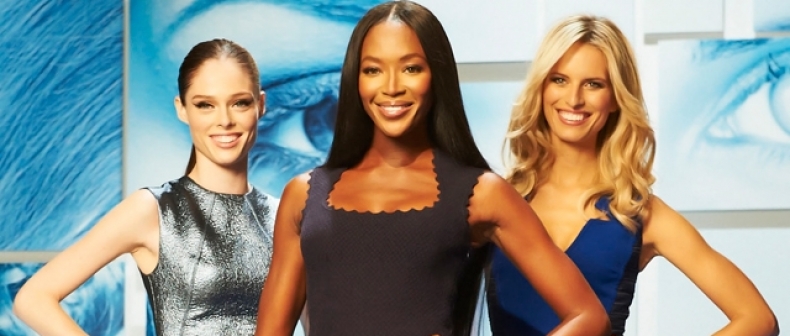
For nine years America’s Next Top Model has towered over its competition like a supermodel in stilettos. It’s the highest-rated show on its network and has its own line of accessories at Wal-Mart. The franchise reaches farther than the British Empire–128 countries have their own versions. Tyra Banks (creator, host, judge, and executive producer) has made a fortune on the series. She holds a unique position in the eyes of the quivering contestants–one part mentor, two parts Goddess of Vengeance.
How can you compete with Tyra? The creators of The Face think they have the answer. If ANTM features one diva model, The Face will star three. The show, premiering on Oxygen next month, brings together three very successful models at different stages of their careers. Naomi Campbell, Karolina Kurkova, and Canada’s own Coco Rocha act as team leaders, competing with each other to help the new models win. It’s like Summer Camp, with less crying and more hairspray. (Well, probably the same amount of crying.) And three models instead of one is The Face‘s only innovation; that the new show is so similar to its predecessor is a testament to ANTM’s abundant success.
Success in terms of ratings, that is. Because here a wee voice, like that of the little boy who questioned why the emperor wore no clothes, begs a question–have any of former contestants, winners or otherwise, gone on to have careers in the fashion industry? Have any of America’s Next Top Models actually become top models? I don’t think they have. American Idol launched multiple music careers (especially after the artists create distance between themselves and Simon Cowell). But viewers forget contestants on ANTM before the final credits roll.
Why can reality TV shows create pop stars but not top models?
For the answer, I went to Dan Grant, who’s in charge of scouting and developing for NEXT Models. He also publishes ModelResource.ca, an online resource for modeling in Canada. It covers everything from finding an agent to developing empathy for teenaged Russian models working overseas. (“People from privileged societies like ours see these girls and think that their parents are awful people for sending them so young…What they don’t understand is, for them it’s their only chance.”) He’s worked in the industry for 16 years. I ask him how he got into the business. He answers, “The wrong way–I married a model.”
To discover emerging talent, Grant travels across the county, visiting conventions and open calls. It’s difficult for him to describe what makes a potential stand out. Other than the obvious physical characteristics, he looks for attitude and upbringing, and whether he thinks the person will be able to adapt to the demands of the industry.
“The model search I was at in Moncton this weekend, the person who was most prone to go on and have a good career from that, she was also the one that had the most supportive parents. They drove in from PEI… Support of parents is a big factor for us.”
Grant’s major problem with shows like ANTM and The Face is the manufactured drama and fierce competition they promote.
In real life, there’s no such thing as one shot photo challenges. “You can teach a girl to walk,” he says, “you don’t eliminate someone with potential because she can’t walk right away. It’s just silly.” Worse still, they encourage young models to think they have to beat each other in order to get ahead.
“Every time I go to conventions, I see it. People who watch these shows think that that’s going to give them a better chance to sign with an agency like mine. They come in with these ideas that they have to beat out every girl in the competition. If there are six great girls, I’m going to take all six of them, not one! It doesn’t matter who wins the award.”
By nurturing competition, these shows pressure the contestants to turn on each other. “It encourages models to think there’s someone in their way, when in fact there’s a wide range of opportunities for models. I get the need for television ratings, but it’s so completely unreflective of how the industry actually operates. What’s the expression I’ve heard? ‘Blowing out someone’s candle doesn’t make yours shine any brighter.’”
In order to create combustible combinations of personalities, reality shows cast contestants based on personality traits rather than their likelihood of becoming professional models. The models, however, are often unaware of this, and are the ones left disappointed and disillusioned.
Grant knows many people who worked on Canada’s Next Top Model, including the three winners. Not winning is a blessing in disguise, but even appearing briefly can affect a young model’s career. Grant knows a model who was eliminated in the very first cut on CNTM. She took that to mean she wasn’t cut out for modeling. Five years later, she’s signed with an agency and is doing well. “She could have been working the whole time. But being part of the show gave her a false sense of what the industry was, and she never pursued it. She’s wasted five years because her introduction to the industry was Canada’s Next Top Model.”
“The models when they come out of the show, they have this completely skewed idea of what the industry is,” he says. He describes one winner telling interviewers that she could get any job now, before even landing her first. “Basically, how these Next Top Model contestants earned their $100,000 contracts was by going around signing autographs at malls across Canada. They didn’t get it by doing endorsement deals. They didn’t get it by doing campaigns or catalogues.” He then mentions how one of the winners of Canada’s Next Top Model now works at a bank. Another sells cars in Waterloo.
Musical reality shows like American Idol are very good at creating B and C-list celebrities, who can stretch their fifteen minutes of fame into fifteen years through commercial endorsements, cameos, planted paparazzi stories, and Twitter. On occasion, they produce music. But for models, starting out famous might actually be a setback.
“There’s a stigma attached to being a reality show winner,” Grant explains. “If you are Zac Posen or Marc Jacobs, you don’t want a reality show winner in your line. Music is for the masses–music is popular consumption. But there’s no exclusivity to being the winner of America’s Next Top Model. Often you want the trashy people on your reality show. You don’t want them [as models]. It brings it down a level.”
The recognizable faces of supermodels like Kate Moss and Linda Evangelista are one thing. But when a model is just starting out, she needs to fit the look that the label or company wants, which is easier to do if she doesn’t come with reality show baggage.
“It overshadows the product. If you’re all looking at the person who won the reality show, you’re not going to notice what they’re wearing.”
Grant represents a young man who was just at men’s fashion week in Paris. Even though he spoke with many designers and was available for multiple collections, Saint Laurent offered him an exclusive deal, which hinged on unveiling him as a new face during their show.
“If he had been through some reality show, they probably wouldn’t have wanted to meet him at the casting.”
Although he reserves a lot of blame for TV executives whose ultimate concern is ratings, Grant acknowledges that the fashion industry itself is also responsible. From the models, photographers, and coaches who act as judges, all the way down to the cosmetic companies that provide the make up, industry insiders lend legitimacy to the premise of these shows. “As long as that keeps going, the cycle will just keep perpetuating.”
____
Max Mosher writes about style for Toronto Standard. You can follow him on Twitter at @max_mosher_.
For more, follow us on Twitter @TorontoStandard or subscribe to our newsletter.














